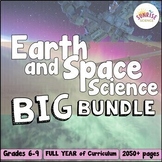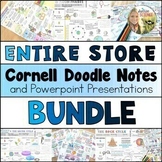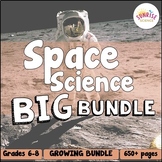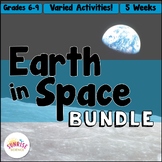Moon Phases Doodle Notes | Waxing Waning Phases of the Moon | Cornell Notes
- PDF
- Internet Activities
What educators are saying
Also included in
- This is a bundle of all of my resources for teaching Earth and Space Science at the middle school level! These resources include a mix of Cornell Doodle Notes, lab activities, inquiry activities, digital lessons and units, projects, and pixel art digital content review activities.✨ Please note thatPrice $327.00Original Price $450.24Save $123.24
- This is a growing bundle of all of my Cornell Doodle Notes on Earth and Space Science topics. This resource currently contains Cornell Doodle Notes, the associated Powerpoint / Google Slides Presentations, and (for most) Google Slides versions of the notes for 16 topics.The topics currently includedPrice $64.00Original Price $80.76Save $16.76
- This is a growing bundle of ALL of my Science Cornell Doodle Notes resources. This bundle currently contains Cornell Doodle Notes and the associated Powerpoint / Google Slides Presentations for 48 science topics. The price at this point reflects what is in the bundle at this time, plus 20% off. As aPrice $189.00Original Price $244.25Save $55.25
- This is a bundle of all of my resources for teaching Space Science at the middle school level! These resources include a mix of Cornell Doodle Notes, lab activities, inquiry activities, digital units with assessments, projects, and pixel art digital content review activities.Receive 25% off this BIGPrice $97.00Original Price $129.34Save $32.34
- Looking for fun, student-centered, and engaging activities to teach about Earth's rotation and revolution, the reason for the seasons, moon phases, gravity and orbiting, solar and lunar eclipses, and the planets and other objects of our solar system?Using all of the resources in this bundle will givPrice $67.00Original Price $85.34Save $18.34
- This mini-bundle contains FOUR sets of Cornell Doodle Notes for teaching or reviewing about the Earth in Space! The topics included are: Earth's Motion (Rotation and Revolution), Reason for the Seasons, The Moon Phases, and Solar and Lunar Eclipses. Get 20% off of these resources by purchasing themPrice $15.49Original Price $19.48Save $3.99
Description
Teach about the Moon Phases using these scaffolded Cornell Doodle Notes! These notes can be used to teach about how and why we can see the Moon from the Earth, how much of the Moon is always lit up by the Sun, the terms waxing, waning, crescent, gibbous, and quarter moon and tricks for remembering what these terms mean, and how the Moon phases are related to the Moon’s position relative to the Sun as seen from the Earth. Graphic organizers and diagrams help students understand these concepts.
These notes were designed to align with NGSS Standards MS-ESS1-1 (Develop and use a model of the Earth-Sun-Moon system to describe the cyclic patterns of lunar phases, eclipses of the Sun and Moon, and seasons.)
Cornell Notes are a note-taking strategy in which topic questions are written in a narrow left-hand column and definitions, explanations, and diagrams are filled in in the right-hand column.
Doodle Notes are another note-taking strategy for which pictures and graphics activate the visual pathways of the brain, which helps with retention of information when compared to standard note-taking. Your visual learners will really benefit from seeing and coloring in the pictures aside the main points of the notes!
What's Included (please see the preview also!):
- The Cornell Doodle Notes are 3-pages each and there are 2 scaffolded versions plus the answer key
- Two presentation options: Powerpoint AND Google Slides
- Google Slides version of the notes with student directions and Google Tools and Fonts sidebar
Here are some ways that I suggest using this resource:
✎ Whole-Group lesson with scaffolding : Decide which students should receive which level of the notes. Hand out the notes to the students. Use the Powerpoint or Google Slides as a presentation and talk aloud through the lesson while the students take notes OR If you have a document camera (an ELMO), you can fill out your own notes and the students can follow along with you as you discuss the concepts aloud! Stop throughout the lesson to have the students pair-share and discuss what they are learning. Allow them to color/doodle further during and at the end of the lesson.
✎ Scaffolded Small-Group lesson : Separate your students into groups by learning level. Give each student group sets of the appropriate notes for their level. Make sure each group has a device to view the presentation. Post the Powerpoint or Google Slides to your Google Classroom or other online learning platform, or email the Powerpoint version to one ‘student leader’ in each group. The students would view the Powerpoint/Slides together on one device and fill in the notes. Encourage them to add color/further notes.
✎ Individual Note-Taking or Flipped Classroom : Post the Powerpoint or Google Slides presentation to your Google Classroom or other online learning platform OR print out the slides and post them around your room -- give students a clipboard! Hand out the appropriate-level notes to each student. Students can work at their own pace to view the presentation and complete their notes. Encourage them to add color/further notes. Could also be assigned for homework or as a “half & half lab” for which one group of students is taking notes at their desks while another group is performing a lab.
✎ Distance Learning Scenario: Create a screencast lecture using one of the presentation options, or you could record audio clips over each slide that your students will play as they view the presentation.
Options for Digital Note-taking:
- Assign the Google Slides version of the notes (please view the Preview to get a better idea of what this version looks like!)
- Assign these notes digitally using the Kami Extension for Google Classroom. Learn about this option by downloading THIS FREEBIE!
Please note that this resource is not editable due to font and clip art licensing agreements and also to protect my work. However, you can always add additional text boxes to the presentation, as well as insert new slides with images/text/video clips, etc. to customize the lesson for you and your students!
Doodle notes is a trademarked term used with permission. Please visit doodlenotes.org for more information.
You may also be interested in these resources:
The Moon Phases Pixel Art Review
Phases of Life Moon Phases Project
Earth's Motion (Rotation and Revolution) Cornell Doodle Notes
Seasons on Earth Cornell Doodle Notes
The Sun-Earth-Moon System Pixel Art Review
Get this resource and save even more $$$ with the Earth and Space Science BIG Bundle!
Thanks for looking!
Sunrise Science











